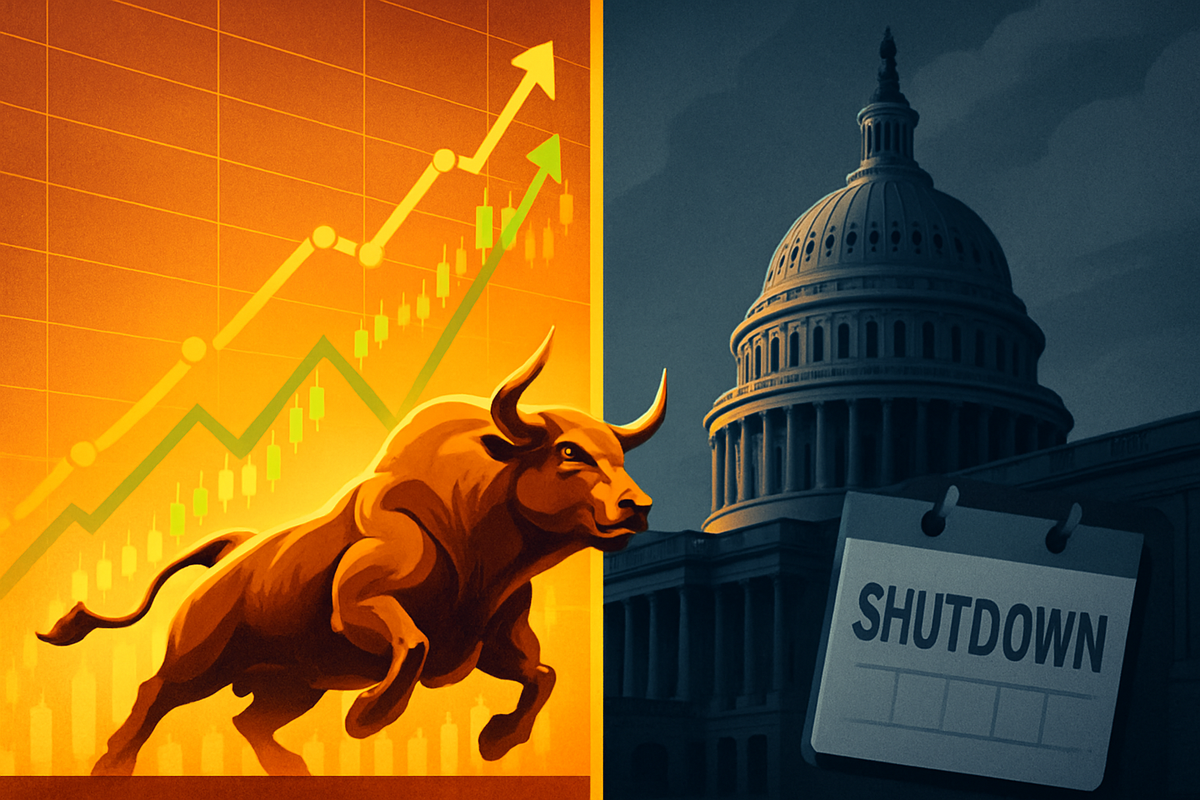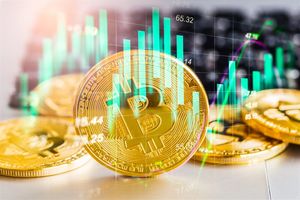Political Gridlock Looms as US Stocks Power Through Government Shutdown Threats

As of October 2, 2025, the United States finds itself in a peculiar economic paradox: a robust stock market rally defying the ominous backdrop of a federal government shutdown. Major indices, including the S&P 500 and Nasdaq 100, have surged to new all-time highs, propelled by an insatiable appetite for technology stocks and the looming prospect of Federal Reserve interest rate cuts. Yet, beneath this veneer of market resilience, the federal government has entered its second day of a shutdown, threatening to furlough hundreds of thousands of employees and casting a shadow of political uncertainty over the nation's economic landscape. This dichotomy presents a complex challenge for investors, as the immediate implications suggest a market largely shrugging off political gridlock, while the potential for prolonged disruption remains a significant concern.
The Federal Freeze: A Deep Dive into the Government Shutdown
The current federal government shutdown, now in its second day as of October 2, 2025, stems from a failure by the U.S. Congress to reach an agreement on a spending bill to fund federal operations for the new fiscal year. This legislative impasse has plunged various government agencies into operational limbo, leading to widespread furloughs and a halt in non-essential services. Approximately 750,000 federal employees are expected to be furloughed without pay, impacting a diverse range of agencies and potentially disrupting critical government functions.
The political tensions surrounding the shutdown have been further exacerbated by President Donald Trump, who has reportedly escalated the situation by threatening mass layoffs of federal workers, some potentially permanent, and signaling cuts to "Democrat Agencies." Adding to the pressure, the President has also announced a pause in $18 million in federal funding for infrastructure projects in heavily Democratic New York City, a move that could have localized economic repercussions. A significant immediate consequence of the shutdown is the delay of crucial economic data reports, including Thursday's weekly jobless claims and Friday's monthly nonfarm payrolls data. This blackout of information could complicate the Federal Reserve's decision-making process regarding future interest rate adjustments, introducing an element of uncertainty into monetary policy. Treasury Secretary Scott Bessent has also issued a stark warning, indicating that a prolonged shutdown could negatively impact overall US economic growth. Despite these significant political and economic disruptions, initial market reactions have been surprisingly muted, with analysts noting that financial markets historically tend to view government shutdowns as temporary political events rather than fundamental threats to long-term economic stability. While some initial market volatility was observed and the S&P 500's early gains slightly fizzled, the overall market trend has remained remarkably positive, buoyed by other powerful economic forces.
Corporate Crossroads: Winners and Losers in a Shutdown Scenario
A government shutdown, even if perceived as temporary by the broader market, inevitably creates winners and losers among public companies. Companies heavily reliant on government contracts, regulatory approvals, or federal funding are likely to face significant headwinds. Defense contractors, for instance, such as Lockheed Martin (NYSE: LMT) or Raytheon Technologies (NYSE: RTX), could see delays in new contracts or payments for ongoing projects, impacting their revenue streams and order backlogs. Similarly, companies in sectors like infrastructure development that depend on federal grants or permits, such as Caterpillar (NYSE: CAT) or AECOM (NYSE: ACM), might experience project delays and increased uncertainty.
Conversely, certain sectors or companies might be less affected or even see indirect benefits. Technology companies, particularly those focused on artificial intelligence (AI) and cloud computing, which are currently driving the market rally, are largely insulated from direct government operational disruptions. Giants like Nvidia (NASDAQ: NVDA), Microsoft (NASDAQ: MSFT), Broadcom (NASDAQ: AVGO), and Alphabet (NASDAQ: GOOGL) are primarily driven by private sector demand and global technological trends, rather than federal spending cycles. Furthermore, companies providing essential services or consumer staples might experience more stable demand. In some cases, a shutdown might even accelerate a shift towards private sector solutions for services previously provided or overseen by the government, creating niche opportunities. However, the overall uncertainty can dampen consumer and business confidence, which could eventually trickle down to broader economic activity, affecting even seemingly insulated sectors.
The Broader Implications: Navigating Economic Headwinds
The current government shutdown, while seemingly shrugged off by a bullish stock market, carries wider significance that could ripple through the economy and financial markets. Historically, government shutdowns, especially prolonged ones, can erode consumer and business confidence, leading to deferred spending and investment. This event fits into a broader trend of increasing political polarization and fiscal brinkmanship in the US, which introduces an element of systemic risk that investors must contend with. Such political uncertainties can deter foreign investment and impact the nation's credit rating if fiscal stability is perceived to be consistently at risk.
The delay in crucial economic data, such as jobless claims and nonfarm payrolls, has significant regulatory and policy implications. The Federal Reserve relies heavily on this data to inform its monetary policy decisions. A prolonged data blackout could force the Fed to make decisions with incomplete information, potentially leading to sub-optimal interest rate adjustments or increased market volatility as investors speculate on the Fed's next moves. This situation could complicate the widely anticipated interest rate cuts, which are currently a major driver of market optimism. In terms of historical precedents, past government shutdowns have shown varying degrees of market impact. While many have been short-lived with minimal lasting effects on equities, extended shutdowns have demonstrably slowed economic growth. For example, the 2013 shutdown was estimated to have shaved 0.1-0.3 percentage points off Q4 GDP growth. The current context, with high inflation concerns and anticipated rate cuts, adds another layer of complexity compared to previous events, making the long-term economic fallout less predictable.
The Path Forward: Scenarios and Strategic Adaptations
Looking ahead, the immediate future hinges on the duration and resolution of the government shutdown. In the short term, if the shutdown is resolved quickly—within days or a week—the market's current resilience, fueled by AI optimism and rate cut expectations, is likely to persist. Any initial dips would likely be seen as buying opportunities. However, a prolonged shutdown, extending for several weeks or more, could lead to more significant economic consequences. The cumulative effect of furloughed workers' lost wages, delayed government services, and the chilling effect on business sentiment could begin to weigh on consumer spending and overall GDP growth, potentially challenging the current market rally.
For public companies, strategic pivots may be necessary. Businesses with significant government contracts may need to activate contingency plans, diversify their client base, or seek alternative revenue streams to mitigate risks. Companies in heavily regulated industries might face delays in permits, licenses, or approvals, necessitating proactive engagement with relevant agencies once operations resume. Market opportunities could emerge for companies offering automation or efficiency solutions, as government agencies might seek to streamline operations post-shutdown. Conversely, challenges will arise for sectors directly dependent on federal disbursements or data. Investors should brace for potential increased market volatility, especially if the political impasse drags on and economic data remains scarce, making it harder to gauge the true health of the economy.
Market Resilience Under Scrutiny: A Final Assessment
In summary, the current US financial landscape is characterized by a striking dichotomy: a surging stock market driven by technological innovation and monetary policy expectations, juxtaposed against the backdrop of a federal government shutdown. Key takeaways include the market's initial ability to "shrug off" political uncertainty, largely due to strong performance in the tech sector (e.g., Nvidia, Microsoft) and the anticipation of Federal Reserve rate cuts. However, the shutdown's implications, such as the furlough of 750,000 federal employees, threats of layoffs, delays in critical economic data, and warnings from the Treasury Secretary, underscore the potential for broader economic disruption if the impasse is prolonged.
Moving forward, the market's resilience will be thoroughly tested. While historical precedents suggest short-term shutdowns have limited lasting impact, the unique confluence of current market drivers—AI boom, liquidity expansion, and imminent rate cuts—with the political gridlock creates an unpredictable environment. Investors should closely monitor developments in Washington, particularly any signs of a bipartisan agreement to fund the government. Beyond the immediate resolution, attention should be paid to how the Federal Reserve navigates monetary policy amidst data blackouts and whether corporate earnings reports from key sectors continue to justify current valuations. The lasting impact of this event will depend not only on its duration but also on how it influences long-term investor confidence in the stability and predictability of the US political and economic system.
This content is intended for informational purposes only and is not financial advice
More News
View More




Recent Quotes
View More
Quotes delayed at least 20 minutes.
By accessing this page, you agree to the Privacy Policy and Terms Of Service.